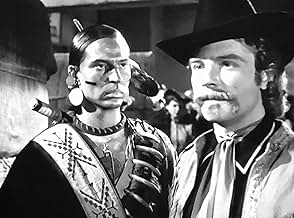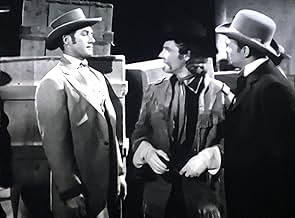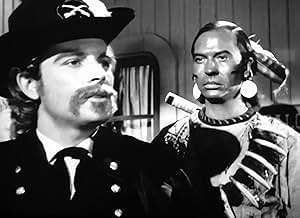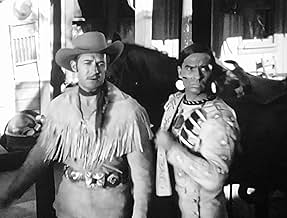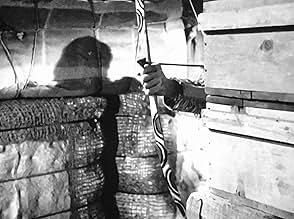Ajouter une intrigue dans votre langueAn adventurer, gambler, and widely respected southern gentleman is recruited to work as a secret agent, at no pay, in post-Civil War New Orleans, helped by his companion, a silent Pawnee Nat... Tout lireAn adventurer, gambler, and widely respected southern gentleman is recruited to work as a secret agent, at no pay, in post-Civil War New Orleans, helped by his companion, a silent Pawnee Native American.An adventurer, gambler, and widely respected southern gentleman is recruited to work as a secret agent, at no pay, in post-Civil War New Orleans, helped by his companion, a silent Pawnee Native American.
Parcourir les épisodes
Avis à la une
. . . they speak of Yancey D."
So went the theme song to this undeservedly short-lived series. Nominally billed as a "western" (Yancey did, after all, wear a broad-brimmed hat, there were horses about, and his best friend was an Indian), this show was hard to categorize, even in the era of the so-called "adult western."
There was always the hint of a dark side to Yancey, all things considered; a feeling that tucked away behind his reserved manner lay a past that may not always have been too cool (or, alternately, as a friend of mine once suggested, perhaps a bit TOO cool). Moreover, unlike most of his contemporary action heroes, Mr. D. didn't always fight fair: forced into a bare-knuckles match against an huge opponent, Yancey took advantage of his knowledge that the guy had spent the previous night guzzling beer, hammering him into collapse with a series of belly punches you could almost feel through the TV screen.
Not the nicest guy in town, in other words. But eminently effective. And thoroughly watchable. A great series.
So went the theme song to this undeservedly short-lived series. Nominally billed as a "western" (Yancey did, after all, wear a broad-brimmed hat, there were horses about, and his best friend was an Indian), this show was hard to categorize, even in the era of the so-called "adult western."
There was always the hint of a dark side to Yancey, all things considered; a feeling that tucked away behind his reserved manner lay a past that may not always have been too cool (or, alternately, as a friend of mine once suggested, perhaps a bit TOO cool). Moreover, unlike most of his contemporary action heroes, Mr. D. didn't always fight fair: forced into a bare-knuckles match against an huge opponent, Yancey took advantage of his knowledge that the guy had spent the previous night guzzling beer, hammering him into collapse with a series of belly punches you could almost feel through the TV screen.
Not the nicest guy in town, in other words. But eminently effective. And thoroughly watchable. A great series.
This was a really a neat and fun TV show to watch. I loved the fact that a Native American was given a decent part in a TV show. X-Brands always seemed so cool and aloof as Pahoo. The writers gave him dignity. It was also a cool concept and interesting that it was set in New Orleans. I enjoyed watching Jock Mahoney in almost anything he ever was in. He always looked so debonair, but capable in this series. I really would hope that this series could be released on DVD. If not on DVD, maybe it could be shown somehow on cable or satellite (TV Land?). The "Range Rider", that he was also in, was a cool show, too. I wouldn't mind seeing that show again, too, either on DVD or TV.
Richard Sale (pulp writer and movie writer and movie producer) teamed up with his wife Anita Loos (Gentlemen Prefer Blondes) to produce 39 episodes of a syndicated show. Jock Mahoney, the stunt man extraordinary and THE RANGE RIDER, was casted as a ex-confederate soldier coming back to a Yankee controlled New Orleans after the war. Opening episode, he and Pahoo were waving a Confederate Flag in the middle of the river to hitch a ride on a riverboat. Audacious and charming was Yancy.
Sonmetimes it is hard to understand just why a television series is so short lived.Lack of popularity is the most common reason of course;sometimes the death of a star ends its run prematurely.In the case of Yancy Derringer, it was corporate greed.Originally financed and owned by the writers and Jock Mahoney, it was so successful in its initial season that the network insisted on buying it.Jock Mahoney and the others refused;the network responded by concealing it.End of Yancy Derringer.
The theme song was one of the most distinctive of 1950's television.It outlived its series,and can be frequently heard as b background music on episodes of "The Rifleman" made in the early 1960's.
It is certainly strange that, considering how many fine TV series were made in the first 20 years of TV, so very few are ever shown,except for "I Love Lucy" and a few others.
The theme song was one of the most distinctive of 1950's television.It outlived its series,and can be frequently heard as b background music on episodes of "The Rifleman" made in the early 1960's.
It is certainly strange that, considering how many fine TV series were made in the first 20 years of TV, so very few are ever shown,except for "I Love Lucy" and a few others.
When I watched Yancy Derringer as a 6 year old, the guns were especially fascinating. Pahoo-Ka-Ta-Wah had a big shotgun, maybe 10 gauge. Yancy had several tiny guns that were hidden in his clothes. One in his hat, one in his boot. He could be searched, but still pull a derringer out of his sleeve. X Brands, as Pahoo-Ka-Ta-Wah, had the biggest shotgun I have every seen. As I recall, it had a single barrel with a mighty power. If needed, Pahoo-Ka-Ta-Wah could blast the bad guys with such force, smoke, kick, and noise, that it was the grand finale to any fight!
The derringers came in a variety of arrangements, with most of them having two barrels. But some may have had more than two. The smallest derringer had only one barrel. There was a trick derringer, if my memory as a boy serves me correctly. One trick derringer was up Yancy's sleeve on a spring-loaded mechanism. It had scissor shaped metal supports that would expand to full length on command of a gesture. The contraption would spring out of his sleeve into Yancy's hand into the right firing position. The gesture that triggered the spring to release was for Yancy to press his elbow against his side. One derringer was hidden in his belt buckle. Toy stores sold belts with hidden derringers after that show!
Pahoo-Ka-Ta-Wah would carry his shotgun with him wherever he went, but with poise and dignity which seemed non-threatening. X Brands' dispassionate face would seldom display any emotion. He spoke slowly and deeply, with somber meaning that always was important. Pahoo-Ka-Ta-Wah was tall and strong. In a fight, I only remember his 8 gauge shotgun: as the ultimate weapon in any New Orleans brawl. It could knock down a wall!
The derringers came in a variety of arrangements, with most of them having two barrels. But some may have had more than two. The smallest derringer had only one barrel. There was a trick derringer, if my memory as a boy serves me correctly. One trick derringer was up Yancy's sleeve on a spring-loaded mechanism. It had scissor shaped metal supports that would expand to full length on command of a gesture. The contraption would spring out of his sleeve into Yancy's hand into the right firing position. The gesture that triggered the spring to release was for Yancy to press his elbow against his side. One derringer was hidden in his belt buckle. Toy stores sold belts with hidden derringers after that show!
Pahoo-Ka-Ta-Wah would carry his shotgun with him wherever he went, but with poise and dignity which seemed non-threatening. X Brands' dispassionate face would seldom display any emotion. He spoke slowly and deeply, with somber meaning that always was important. Pahoo-Ka-Ta-Wah was tall and strong. In a fight, I only remember his 8 gauge shotgun: as the ultimate weapon in any New Orleans brawl. It could knock down a wall!
Le saviez-vous
- AnecdotesThe decaying Southern mansion seen on the series was the Tara set from Autant en emporte le vent (1939), which stood on the back lot at Desilu Studios (formerly Selznick International Pictures). The facade was sold and moved to Georgia in 1959.
- ConnexionsFeatured in TV's Western Heroes (1993)
Meilleurs choix
Connectez-vous pour évaluer et suivre la liste de favoris afin de recevoir des recommandations personnalisées
- How many seasons does Yancy Derringer have?Alimenté par Alexa
Détails
- Durée
- 30min
- Couleur
- Mixage
- Rapport de forme
- 1.33 : 1
Contribuer à cette page
Suggérer une modification ou ajouter du contenu manquant


